Lilies marchagon hybrids: popular varieties, their planting and care rules
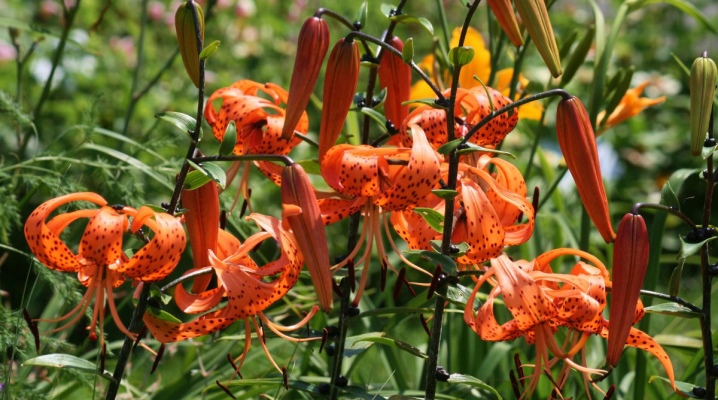
Lily martagon is one of the most delightful flowers that contribute to the creation of a harmonious landscaping of the infield. The beauty and sophistication of flowering bushes gives a positive emotional boost to the hosts and guests.

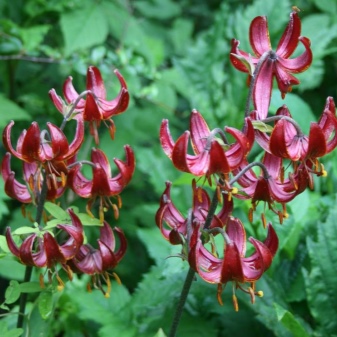
Description of the group of hybrids
Curly lily marchagon with royal curls has been known since medieval times. The long-lasting plant was initially only white in color. Later, multi-colored hybrids were bred. There are more than 200 varieties of them. They amaze with their diverse color palette: snow-white, cherry, purple, orange, sand, yellow tones. Most of the hybrids were obtained in Holland by crossing the Marchagon and Hanson lilies. The combination with the Qingdao lily is characterized by larger corollas.
There are 3 main groups.
- The group of hybrids was named Markhan. Delicate flower petals are covered with dark specks. The corolla size is 5 cm in diameter. The Markhan group includes various varieties with lilac, red, pink, orange, and yellow shades. The GF Wilson variety is characterized by lemon flowers, EI Elvs - bronze flowers, Helen Wilmott - light terracotta buds.
- The paisley group is represented by lilac and orange lilies with small specks. The growth of the bush reaches one and a half meters.
- The backhouse group has a wide variety of color palettes. A distinctive feature is the contrasting colors of the outer and seamy sides of the petal. The stem grows up to two meters.
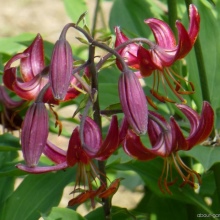
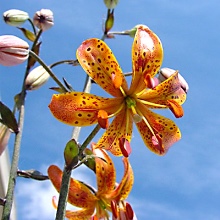
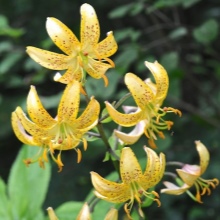
The plant is a shrub with high peduncles. On them you can count 50 pyramidal carpal inflorescences with many flowers. Overly curled up petals look like curly curls. Lilies with wonderful specks scattered over the petal resemble an elegant turban. Because of this feature, the flower is often referred to as the Turkish lily.
The frost-resistant plant is distinguished by great endurance, so it fits perfectly into the climatic conditions of central Russia. The shrub does not require special insulation in the cold.
In Siberia, flowers are affectionately called "cuckoo tears", "sardana", "saranka", and they dedicate poems and songs to them.
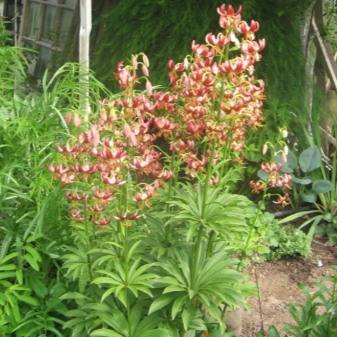
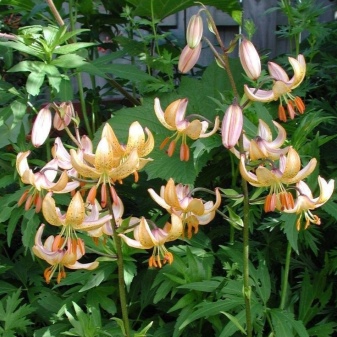
The buds may differ from each other in pubescence and color. The shape of the leaf also sometimes has some differences. There are several varieties of hybrids.
- The typical subspecies has slight pubescence, curled petals of lilac or dark pink color with dark specks. Broad leaves are located in the middle of the stem. Naked purple-red lilies with many black dots are also of this type. This subspecies includes naked white flowers without specks with yellowish pollen and snow-white lilies with pink specks.
- Dalmatian subspecies grows in the Balkans. The abundantly pubescent flowers are very dark in color: beet, wine and red-chestnut tones. There are no specks. The reddish stem can grow up to two meters.
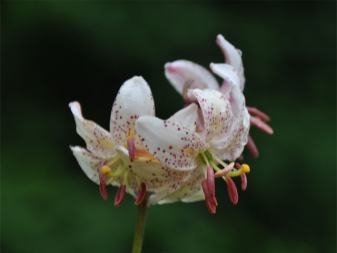
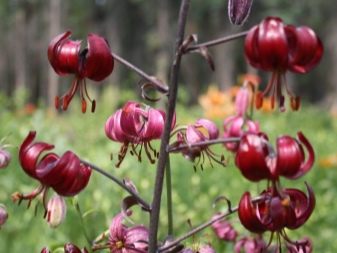
Lily blooms from June to the second half of July. Some varieties bloom in August. Flowers hang down from the stems. Glossy whorled leaves grow on powerful stems. Tubers are represented by egg-shaped bulbs. They are covered with scales. Their life expectancy is up to 50-60 years.
The disadvantages of the plant include the small number of hybrid varieties and a low coefficient of vegetative reproduction.Children rarely appear on the bulbs, the daughter bulbs bud off very slowly. Seedlings develop from seeds for a long time, the first flowering can occur only after 8 years, and from scales - after about 5 years.
It is not recommended to place flowers in a vase and keep them in an apartment because of the pungent odor exuding. The sugary-sweet scent can cause allergic reactions and severe headaches in people.
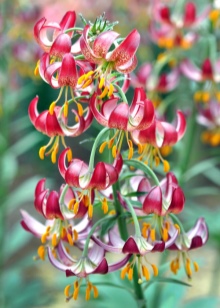
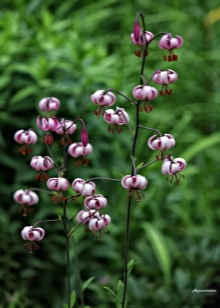
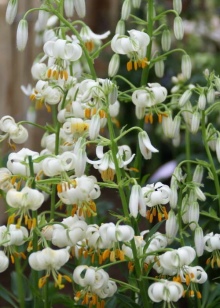
The best varieties
Most of the varieties are striking in their uniqueness and sophistication. Hybrids vary in color, for example, Blushing Moning is characterized by red flowers, and Scout has a bright brick-orange color. The size of the stem, leaves, corolla and speck is also important.
Several varieties are very popular.
- Album is a white lily without specks. Very similar to white porcelain. The petals are bent inward.
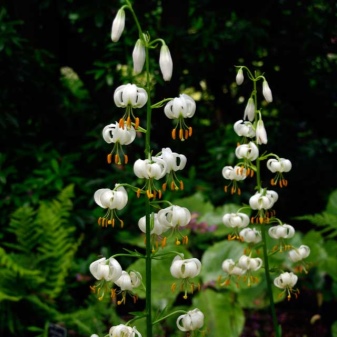
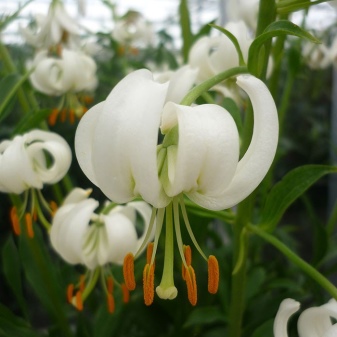
- Pearl is a very rare hybrid. The flower resembles a large turban. The diameter of the bud reaches 15 cm.
On the petals there are dark pink or purple specks.
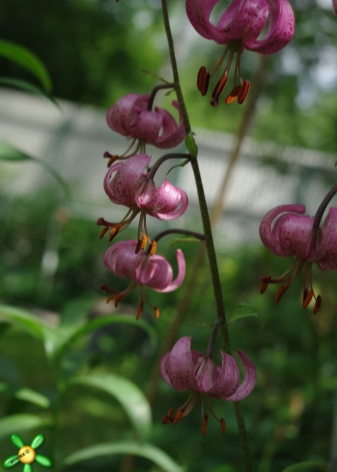
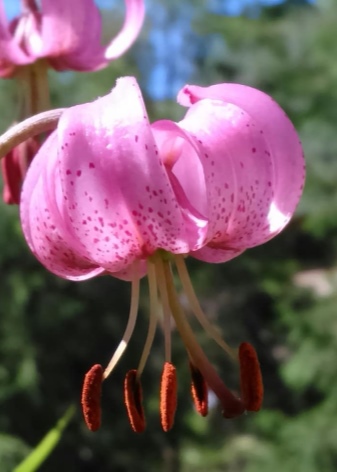
- "Arabian Knight" has an incredible spicy aroma. The flowers can be dark burgundy, bright pink with dark yellow spots. On one stem, it is located in pyramidal inflorescences from 40 to 55 flowers, each of which has a diameter of about 10 cm.


- "Guinea Gold" is a multi-flowered lily. The bush can grow up to one and a half meters. On each stem, up to 50 lilies are formed, the diameter of which can reach 8 cm. The bud has an unusual color: a yellow-pinkish tone on the outside, a bright lilac inside out. The petal has light edges, the base is dark orange. The plant blooms for a long time and abundantly.

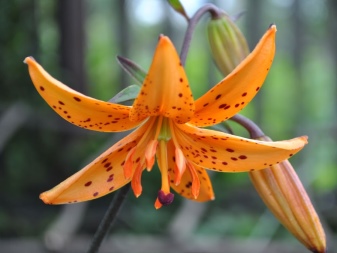
- "Chameleon" - a large lily from white to orange with bright dots. The flower diameter reaches 16 cm. This is one of the most common varieties. The plant can grow up to 1.7 m. It blooms in July. The variety got its name for its ability to change color during flowering. At first, the flower has a pink tone, then gradually acquires a yellow tint with a greenish core.
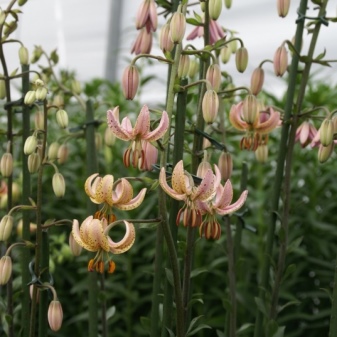
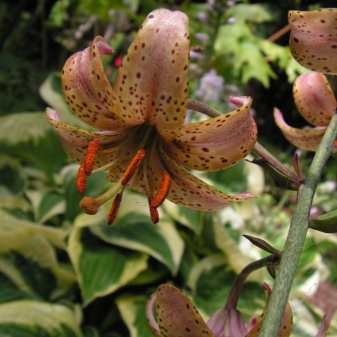
- "Pink Morning" - light pink lily with dark dots. Corolla diameter is 25 cm. In a small racemose inflorescence from 5 to 15 flowers. The growth of straight, powerful stems averages from 1.20 to 1.30 m. The plant has oblong dark green leaves.
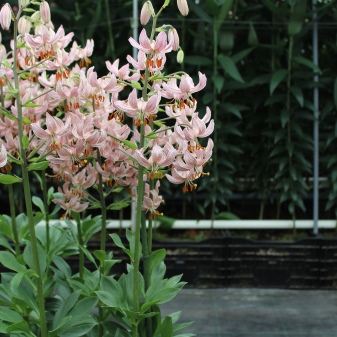
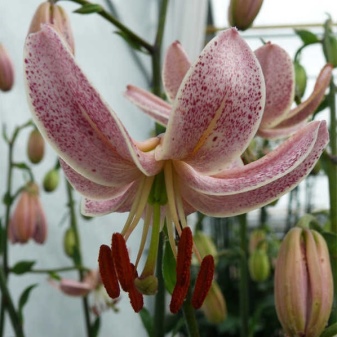
- "Claude Shride" - a rare hybrid of stunning beauty with long orange stamens. Its flowers exude a delicate scent. The petals are dark burgundy in color. Up to 50 flowers bloom on one stem.
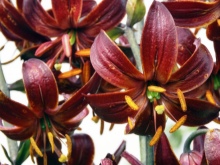
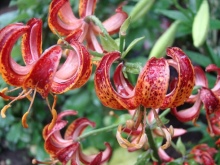

Landing rules
The most suitable time for planting seedlings in open ground is from the second half of August to mid-September. For planting, you must choose a well-lit area with drained soil. From direct sunlight from the south, it is recommended to create shade with trees or shrubs.
For 1 sq. m you need to make the following composition of fertilized soil: 150 g of products with trace elements, 500 g of bone meal (wood ash can be used) and 2 buckets of humus. With acidified soil, 1 glass of lime is poured into the finished mixture. Then the resulting mass is thoroughly mixed. A half-meter hole is dug into which the prepared mixture is added.
For planting, strong large bulbs with intact scales are chosen. Dried onions should be kept in Zircon solution for 2-3 hours.
They are planted to a depth of 25 cm, then sprinkled with a pre-prepared substrate.
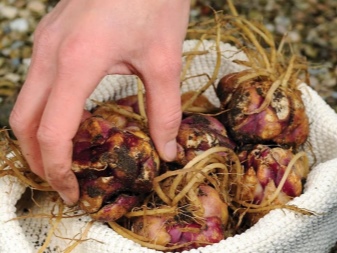
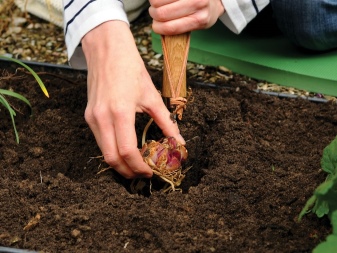
During the autumn planting, you need to prepare leaf humus and peat for mulching. Mixed organic material is used to create a 10-15 cm layer.
Onions pickled in Fundazole (0.2% suspension) are planted. At the planting site of the seedling, it is necessary to create a mound of fertilized soil. On it, very carefully, you need to lay out the roots and sprinkle them with the same earth.
Seedlings in the open field grow very slowly.In the first season, only one shoot is formed, the height of which is approximately 20 cm. Sometimes full-fledged stems appear only after 2 years, because all the efforts of the lily are aimed at strengthening the rhizome.
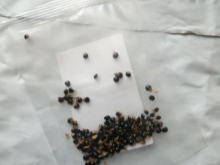


Care features
The plant is unpretentious to care for. He does not need special land and weeds are not scary. In the same area, a lily can bloom for 20 years. During the entire growing season, the soil must be loosened, watered and mulched. This lily variety does not like waterlogging. Excessive irrigation can lead the plant to fungal infections. Moderate watering is carried out directly under the root as the soil dries.
It is recommended to feed hybrids 2 years after planting. The feeding scheme is standard: in the spring, lilies are fertilized with minerals, at the end of flowering, potassium-phosphorus fertilizers are used. Systematic organic mulching can replace top dressing. It is better to underfeed Martagons than to overfeed. To avoid root burns, it is not advised to fertilize lilies with fresh mullein.
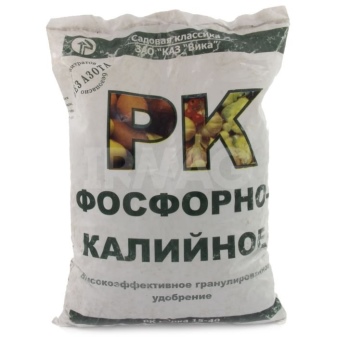
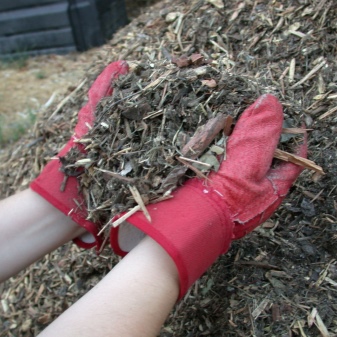
The first top dressing of the season must be done before the emergence of shoots. It is recommended to sprinkle any nitrogen-containing salt directly on the melted snow in April.
At the end of flowering, you need to cut off the peduncle. In a snowless winter, cover the plant with some kind of material, it is best to cover it with spruce branches.
Reproduction methods
There are various ways to grow lily hybrids.
- Scaly considered the most effective breeding method for lily hybrids. In the fall, several outer scales are separated from the mother onion, which are thoroughly washed and disinfected. Potassium permanganate or fungicide is used for disinfection. The scales are kept on damp perlite in a warm room. They need diffused lighting. After 2 months, small bulbs appear at their bases. Then the scales with onions are shallowly dropped into a container with earth, left for the winter in a cool room. They can be slightly covered in frosty weather. Scales from the bulbs should not be torn off, because they feed the bulb until it grows roots. If the flake has not dried out and has not fallen off before planting, the bulb is planted with it. When the scales rot, it should be cut off, smearing the damaged part with brilliant green.
The first flowers appear 4-5 years after planting.
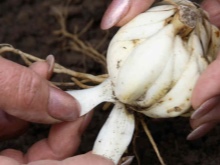
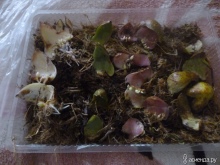
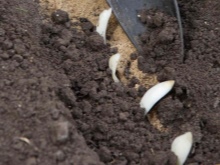
- Seeds can be purchased at specialized retail outlets or obtained from boxes prudently left on the plant. They must be removed in August. It is advised to pollinate no more than 2 flowers, which it is desirable to mark with a bright thread. The rest of the flowers are torn off after wilting. Pollination is usually carried out by nocturnal insects, which are attracted by the heady aroma of the flower. The gardener can pollinate the lily on his own using a brush and a piece of foil. First, in a folded bag, they shake off the pollen from one flower and sprinkle it on another pistil, which is immediately covered with the same bag to avoid re-pollination. Ripe seed pods are removed and dried thoroughly in a dry room. Then the seeds are laid out in paper bags and placed in the refrigerator. In the cool, after 3 months, bulbs begin to form, from which a small sprout will appear by spring. Sometimes the seeds are sown immediately after they are harvested. The onion appears in the summer, in the winter it forms a bud, from which the first leaf should hatch in the spring.
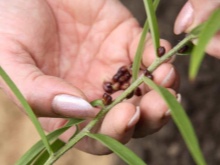
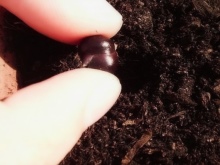

- Curly lily is propagated by childrenformed during the growing season around the onion. Several small cubs are growing on the "womb". They are carefully detached from the onion and dropped into another place.
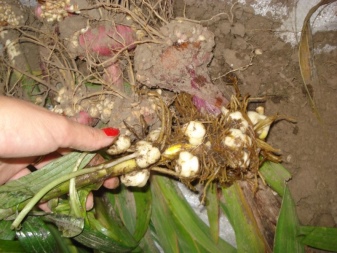
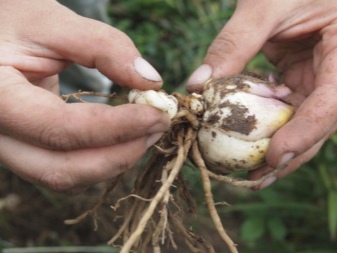
- The division of the onion is as follows: it is dug up, cut into several slices and planted separately in a suitable area.



- Leaf during the beginning of bud formation torn off together with the base and planted in a container with soil.It is deepened in an inclined state to the middle. To strengthen the rhizome, you need to create a greenhouse effect using a plastic bag, which is covered with a container with a leaf.
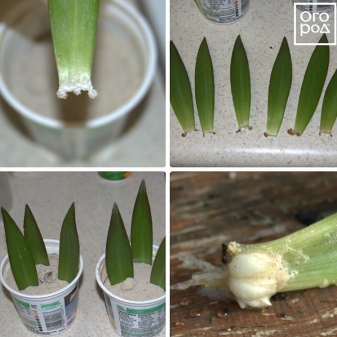

- Reproduction by means of the stem takes place from spring to autumn. It should be separated from the onion by making cuts along the cutting and immediately placed in the soil.
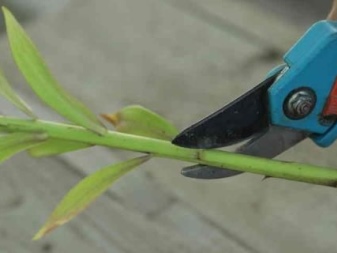

Diseases and pests
Martagon lilies rarely get sick. They are resistant to fungal and viral diseases. But preventive measures should still be taken. It is necessary to treat the plant with "Fundazol" and "Oxychom" 2 times a year: during the beginning of growth and just before flowering.
In poorly ventilated areas, in damp weather, the lily can be attacked by the botrytis fungus, in which the leaves are covered with gray-brown spots. "Fitosporin" is used as a prophylactic agent.
The plant is treated with it 2 times with a two-week break.
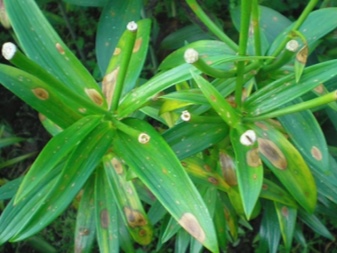
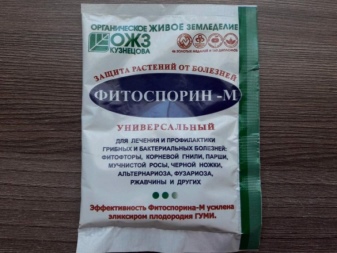
At the stage of bud formation, the lily fly inflicts great damage to the flower. The bud cannot open and falls off. Sometimes deformed lilies bloom. Damaged buds and flowers must be plucked and destroyed. The next season should be started by spraying the bush with Aktara insecticide. It is advisable to spray the substance 2-3 times in May with a two-week interval.
Lily beetles devour stems and leaves. These small red insects periodically attack lilies. They are fought with the same methods as with the Colorado potato beetle.
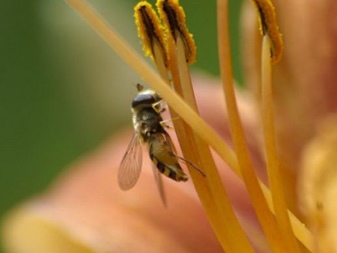
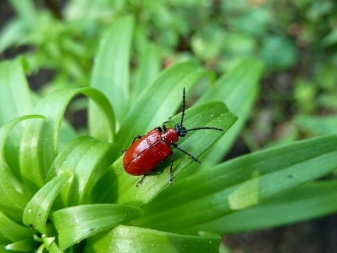
Examples in landscape design
Exotic decorative lilies perfectly decorate any summer cottage or garden plot. They fit perfectly into their landscape design. The most suitable flower beds and flower beds for a plant are shady areas. Lilies look amazing, growing separately and adjacent to different flowers, bushes and trees.
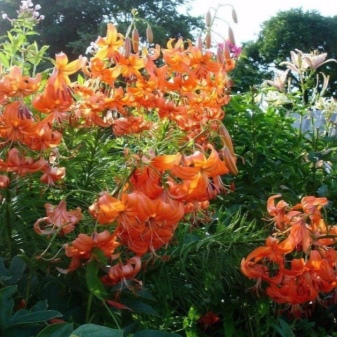
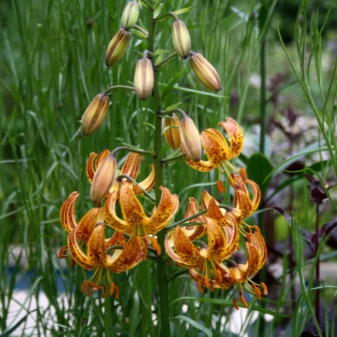
The bush gets along well with lungwort, primrose, fern, dioecious volzhanka, clematis, bellflower, daffodil, incense, jasmine, roses, peonies, fuchsias, tulips, rhododendrons, hosts, juniper, cypress and thuja.
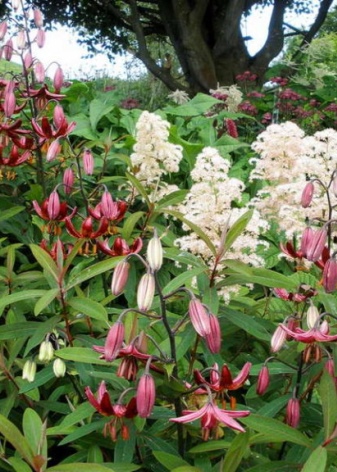
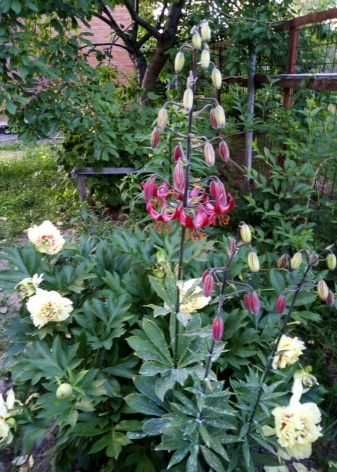
Often, lilies are used to decorate the back of the site. When combining hybrids of lilies with other flowers, it is necessary to take into account the growth, flowering time, color of plants and their agricultural needs. The tallness of the bushes makes it possible to frame gazebos, reservoirs and various fences with them.
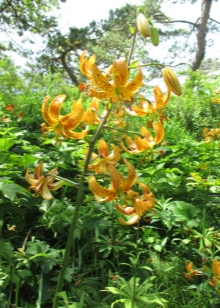
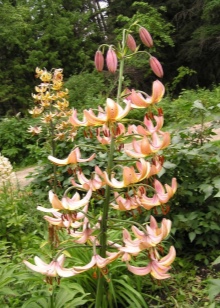

For more information about the lily marchagon, see the next video.







































































































The comment was sent successfully.